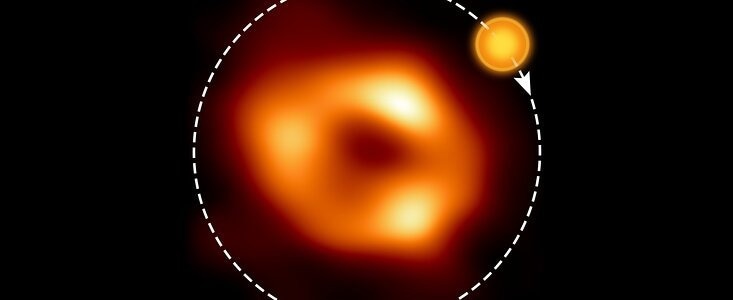With the help of the Atacama Large Millimeter/submillimeter Array (ALMA), astronomers have discovered indications of a “hot spot” orbiting Sagittarius A*, the black hole in the middle of the galaxy. The discovery helps to properly understand the dynamic and enigmatic setting of the supermassive black hole.
 This shows a still image of the supermassive black hole Sagittarius A*, as seen by the Event Horizon Collaboration (EHT), with an artist’s illustration indicating where the modeling of the ALMA data predicts the hot spot to be and its orbit around the black hole. Image Credit: EHT Collaboration, ESO/M. Kornmesser (Acknowledgment: M. Wielgus)
This shows a still image of the supermassive black hole Sagittarius A*, as seen by the Event Horizon Collaboration (EHT), with an artist’s illustration indicating where the modeling of the ALMA data predicts the hot spot to be and its orbit around the black hole. Image Credit: EHT Collaboration, ESO/M. Kornmesser (Acknowledgment: M. Wielgus)
We think we're looking at a hot bubble of gas zipping around Sagittarius A* on an orbit similar in size to that of the planet Mercury, but making a full loop in just around 70 minutes. This requires a mind-blowing velocity of about 30% of the speed of light!
Maciek Wielgus, Study Lead Author, Max Planck Institute for Radio Astronomy
The study was recently published in the journal Astronomy & Astrophysics.
The observations were performed using the ALMA in the Chilean Andes—a radio telescope co-owned by the European Southern Observatory (ESO)—during the Event Horizon Telescope (EHT) Collaboration project to capture black hole images.
In April 2017, the EHT connected eight current radio telescopes from around the world, including ALMA, delivering the first-ever image of Sagittarius A* in recent times.
To standardize the EHT data, Wielgus and his contemporaries, who are members of the EHT Collaboration, used ALMA data recorded concurrently with the EHT interpretations of Sagittarius A*. To the team’s astonishment, there were excess clues to the characteristics of the black hole concealed in the measurements captured only using the ALMA.
By coincidence, a few of the observations were performed soon after a flare or burst of X-ray energy was released from the center of the galaxy, which was seen by NASA’s Chandra Space Telescope. These flares, formerly seen with X-ray and infrared telescopes, are believed to be related to so-called “hot spots,” hot gas bubbles that orbit rapidly near the black hole.
“What is really new and interesting is that such flares were so far only clearly present in X-ray and infrared observations of Sagittarius A*. Here, we see for the first time a very strong indication that orbiting hot spots are also present in radio observations,” says Wielgus, who is also associated with the Nicolaus Copernicus Astronomical Centre, Poland and the Black Hole Initiative at Harvard University, USA.
Perhaps these hot spots detected at infrared wavelengths are a manifestation of the same physical phenomenon: as infrared-emitting hot spots cool down, they become visible at longer wavelengths, like the ones observed by ALMA and the EHT.
Jesse Vos, PhD Student, Radboud University
For a long time, the flares were believed to have originated from magnetic interactions in the extremely hot gas orbiting very near Sagittarius A*, and the new discoveries back this idea.
Now we find strong evidence for a magnetic origin of these flares and our observations give us a clue about the geometry of the process. The new data are extremely helpful for building a theoretical interpretation of these events.
Monika Mościbrodzka, Study Co-Author, Radboud University
ALMA enables astronomers to explore polarized radio emissions from Sagittarius A*, which can be used to expose the magnetic field of the black hole. The researchers used these observations and theoretical models to study more about the hot spot's development and the setting in which it is rooted, including the magnetic field surrounding Sagittarius A*.
Their study offers more robust constraints on this magnetic field’s shape than earlier observations, aiding astronomers in exposing the characteristics of the black hole and its environment.
The observations validate a few of the earlier discoveries carried out by the GRAVITY instrument at ESO’s Very Large Telescope (VLT), which detects in the infrared. The data from GRAVITY and ALMA indicate the flare arose in a cluster of gas twirling around the black hole at around 30% of the speed of light in a clockwise direction in the atmosphere, with the orbit of the hot spot being virtually face-on.
In the future, we should be able to track hot spots across frequencies using coordinated multiwavelength observations with both GRAVITY and ALMA—the success of such an endeavor would be a true milestone for our understanding of the physics of flares in the Galactic center.
Ivan Marti-Vidal, Study Co-Author, University of València
The researchers are also anticipating observing the orbiting gas clumps with the EHT, searching ever nearer the black hole, and studying more about it.
“Hopefully, one day, we will be comfortable saying that we ‘know’ what is going on in Sagittarius A*,” Wielgus concludes.
Journal Reference
Wielgus, M., et al. (2022) Orbital motion near Sagittarius A∗ Constraints from polarimetric ALMA observations. Astronomy & Astrophysics. doi.org/10.1051/0004-6361/202244493.